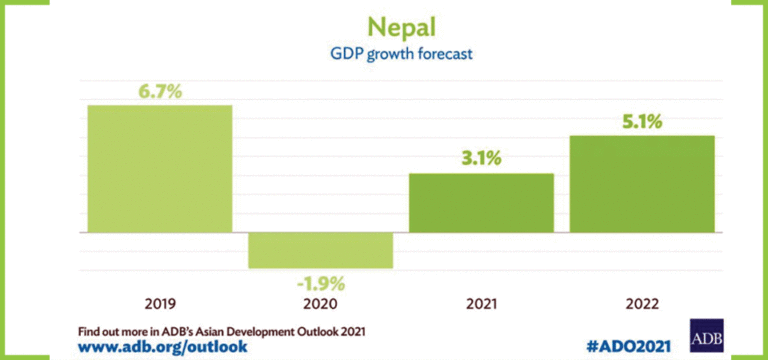
Nepal’s economy is anticipated to grow by 3.1 per cent in the current fiscal year 2020/21 from a contraction of 1.9 per cent in last fiscal year 2019/20, said Asian Development Outlook (ADO) 2021, the flagship economic publication of the Asian Development Bank (ADB).
Growth is expected to recover from the low base in fiscal year 2020, as a result of the gradual lifting of nationwide lockdown since July 2020, and a pickup in domestic demand.
The ongoing vaccination campaigns against the coronavirus (COVID-19) pandemic will help strengthen the economic impetus.
“The COVID-19 contagion that seemed to have tapered off until end-March 2021 is now spreading rapidly. If strict containment measures that have been initiated to tackle this second wave of infections are necessary for a prolonged period in the remainder of this fiscal year, then GDP growth will be lower than the forecast,” said ADB Officer-in-Charge for Nepal Sharad Bhandari.
Agriculture is expected to rise by 2.4 per cent in FY2021 as paddy yield is likely to increase by 1.3 per cent, owing to a good monsoon and increased acreage under production.
Manufacturing and service industries gradually reopened following the end of the lockdown since July 2020.
The affected industries, including micro, small, and medium-sized enterprises (MSMEs) have been receiving economic support in the form of concessional lending and refinancing of existing loans to mitigate the adverse impact of the downturn.
Construction began to pick up, while the completion of some major projects of the government is expected to boost economic recovery. The Upper Tamakoshi Hydropower is expected to begin its first phase of production, while water from the Melamchi Water Supply Project began flowing since March 2021.
Overall, industry is expected to grow by 2.5 per cent after contracting by 4.2 per cent in FY2020. The services sector is expected to grow by 3.4 per cent in FY2021, though hospitality, travel, and tourism sub-sectors will take a longer time to recover.
The ADO 2021 forecasts inflation to moderate to an average of 5 per cent in FY2021, down from 6.2 per cent in FY2020, on the back of a good harvest, smoother supply chains, and subdued non-food prices.
GDP growth of 5.1 per cent is envisaged for FY2022 in anticipation of vaccination progress against COVID-19, regional and global economic recovery from this pandemic, assumption of a good monsoon leading to better harvest, and steady inflows of workers’ remittance.
Economic growth in developing Asia is set to rebound to 7.3 per cent this year, supported by a healthy global recovery and early progress on coronavirus disease (COVID-19) vaccines, according to a new report from the Asian Development Bank (ADB).
The projected resurgence follows a 0.2 per cent contraction last year, according to the ADB’s flagship economic publication.
The region’s growth is forecast to moderate to 5.3 per cent in 2022. Excluding the newly industrialized economies of Hong Kong, China, the Republic of Korea, Singapore, and Taipei, China, developing Asia’s economic activity is expected to grow 7.7 per cent this year and 5.6 per cent in 2022.
“Growth is gaining momentum across developing Asia, but renewed COVID-19 outbreaks pose a threat to recovery,” said ADB Chief Economist Yasuyuki Sawada. “Economies in the region are on diverging paths. Their trajectories are shaped by the extent of domestic outbreaks, the pace of their vaccine rollouts, and how much they are benefiting from the global recovery.”
Rising exports are boosting some economies in developing Asia amid strengthening global economic activity, including a rebound in manufacturing.
Progress on the production and delivery of COVID-19 vaccines has contributed to this momentum, but the pandemic remains the biggest risk for the region as potential delays in vaccine rollouts or significant new outbreaks could undermine growth.
Other risks include increasing geopolitical tensions, production bottlenecks, financial turmoil from tightening financial conditions, and long-term scarring—for instance, learning losses due to school closures.
Most economies in developing Asia will see healthy growth this year and in 2022.
Central Asian economies are forecast to grow 3.4 per cent on average this year and 4 per cent next year.
The trade-dependent economies of Southeast Asia will also recover, with the sub-region forecast to grow 4.4 per cent this year and 5.1 per cent in 2022 after contracting 4 per cent in 2020.
Pacific economies, still affected by global travel restrictions and a collapse in tourism, will post modest growth this year at 1.4 per cent, before expanding by 3.8 per cent next year.
India’s economy, meanwhile, is expected to grow 11 per cent in fiscal year (FY) 2021, which ends on 31 March 2022, amid a strong vaccine drive. However, the recent surge in COVID-19 cases may put this recovery at risk. India’s GDP is expected to expand 7 per cent in FY2022.
This year, South Asia’s GDP growth is expected to rebound to 9.5 per cent, following a 6 per cent contraction in 2020, before moderating to 6.6 per cent next year.
Inflation in developing Asia is projected to fall to 2.3 per cent from 2.8 per cent last year, as food-price pressures ease in India and the PRC. The region’s inflation rate is forecast to rise to 2.7 per cent in 2022.
Source : THE RISING NEPAL,





